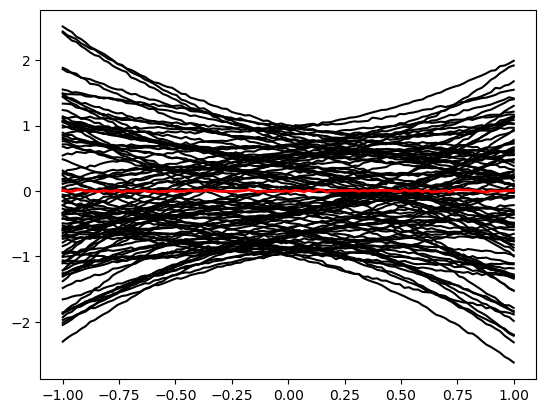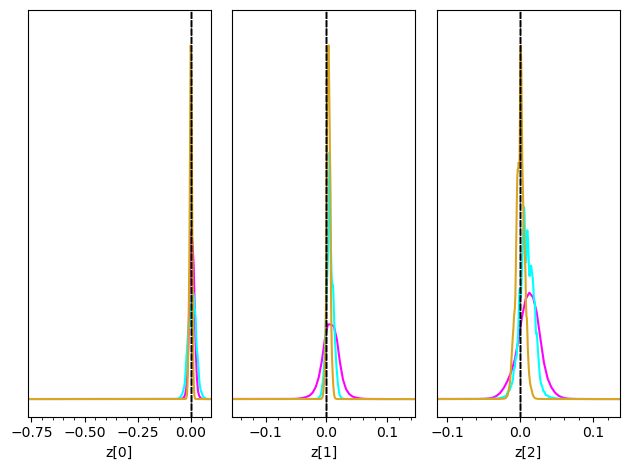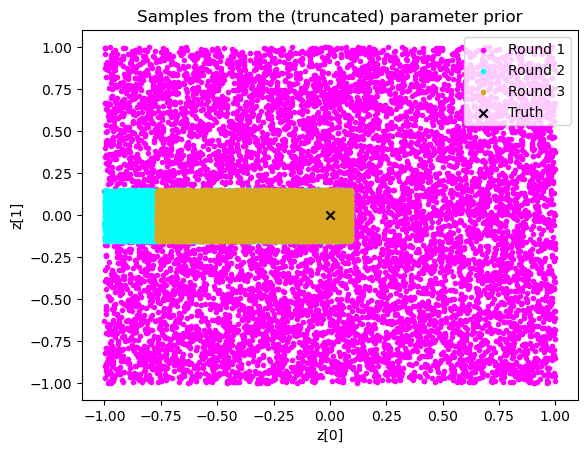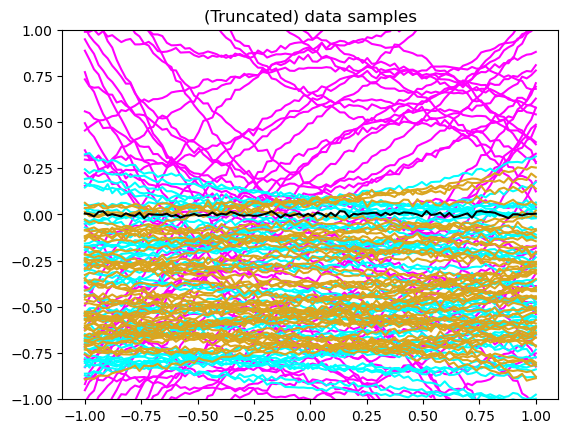This page was generated from notebooks/0H - Truncation and bounds.ipynb.
H - Truncation and bounds#
Authors: Noemi Anau Montel, James Alvey, Christoph Weniger
Last update: 15 September 2023
Proposal: A simple example of truncated marginal neural ratio estimation (TMNRE).
Key take-away messages: Reducing data variance with truncation helps with simulation budgets and networks learning capacity.
Code#
[1]:
import numpy as np
import pylab as plt
from scipy import stats
import swyft
import torch
DEVICE = 'gpu' if torch.cuda.is_available() else 'cpu'
[2]:
torch.manual_seed(0)
np.random.seed(0)
Often we want to generate vectors whose components are drawn from different priors. This can be done with the swyft.RectBoundSampler object. An example:
[3]:
sampler = swyft.RectBoundSampler([stats.norm(0, 1), # Standard normal prior
stats.uniform(-1, 1), # Uniform prior on the interval [-1, 0]
stats.norm(5*np.ones(10), 0.01) # 10 parameters 5 +- 0.01
])
sampler() # Returns a 12-dim vector
[3]:
array([ 1.12644856, -0.02138166, 5.00838619, 4.99903293, 5.00773982,
4.98816343, 5.00358248, 4.98934626, 5.01595224, 5.00054793,
4.99784431, 4.99370637])
This object provides convient functions to sample from truncated versions of the priors. Those have to be specified as argument bounds. Bounds should have the shape \(N_\text{params} \times 2\). An example:
[4]:
bounds = np.array([[1., 1.1], [0.5, 0.6]])
sampler = swyft.RectBoundSampler([stats.norm(0, 1), stats.uniform(-1, 2)], bounds = bounds)
sampler()
[4]:
array([1.04431981, 0.55684339])
We will use the simulator from the linear regression exercise above. Instead of sampling with np.random.rand, we will however use the RectBoundSampler. We also will reduce the noise level.
[5]:
class Simulator(swyft.Simulator):
def __init__(self, Nbins = 100, sigma = 0.01, bounds = None):
super().__init__()
self.transform_samples = swyft.to_numpy32
self.Nbins = Nbins
self.y = np.linspace(-1, 1, Nbins)
self.sigma = sigma
self.sample_z = swyft.RectBoundSampler(stats.uniform(np.array([-1, -1, -1]), np.array([2, 2, 2])), bounds = bounds)
def calc_m(self, z):
m = np.ones_like(self.y)*z[0] + self.y*z[1] + self.y**2*z[2]
return m
def build(self, graph):
z = graph.node('z', self.sample_z)
m = graph.node('m', self.calc_m, z)
x = graph.node('x', lambda m: m + np.random.randn(self.Nbins)*self.sigma, m)
We now generate a mock observation \(\mathbf x_0 \sim p(\mathbf x| \mathbf z_0)\) with some simple parameter vector \(\mathbf z_0 = (0, 0, 0)^T\). We contrast it with random draws from the simulator, \(\mathbf x \sim p(\mathbf x)\).
[6]:
sim = Simulator()
obs = sim.sample(conditions = {'z': np.array([0, 0, 0])})
samples = sim.sample(100)
for i in range(len(samples)):
plt.plot(sim.y, samples[i]['x'], 'k')
plt.plot(sim.y, obs['x'], 'r', lw=2)
[6]:
[<matplotlib.lines.Line2D at 0x1627d5fa0>]

Furthermore, we use again our standard inference network with linear compression.
[7]:
class Network(swyft.SwyftModule):
def __init__(self):
super().__init__()
self.lin = torch.nn.Linear(100, 10)
self.logratios = swyft.LogRatioEstimator_1dim(num_features = 10, num_params = 3, varnames = 'z')
def forward(self, A, B):
f = self.lin(A['x'])
logratios = self.logratios(f, B['z'])
return logratios
We now define a function that performs a single “round” of simulation, training and evaluation. As arguments, it only takes the bounds to use for the simulation, and the target obs for inference.
[8]:
def round(obs, bounds = None):
sim = Simulator(bounds = bounds)
samples = sim.sample(10000)
dm = swyft.SwyftDataModule(samples, batch_size = 64)
trainer = swyft.SwyftTrainer(accelerator = DEVICE, precision = 64)
network = Network()
trainer.fit(network, dm)
prior_samples = sim.sample(N = 10000, targets = ['z'])
predictions = trainer.infer(network, obs, prior_samples)
new_bounds = swyft.collect_rect_bounds(predictions, 'z', (3,), threshold = 1e-6)
return predictions, new_bounds, samples
The only new function is here swyft.collect_rect_bounds, which takes a collection of log ratio estimators as first argument, and then collects 1-dim bounds for the indicated parameter z. The shape of z must be specified explicitly for the collection algorithm to work.
Now let’s do three rounds of simulation, training, evaluation and bound determination.
[9]:
bounds = None
prediction_rounds = []
bounds_rounds = []
samples_rounds = []
for n in range(3):
predictions, bounds, samples = round(obs, bounds = bounds)
prediction_rounds.append(predictions)
bounds_rounds.append(bounds)
samples_rounds.append(samples)
print("New bounds:", bounds)
GPU available: True (mps), used: False
TPU available: False, using: 0 TPU cores
IPU available: False, using: 0 IPUs
HPU available: False, using: 0 HPUs
/Users/cweniger/opt/anaconda3/envs/native2/lib/python3.9/site-packages/pytorch_lightning/trainer/setup.py:200: UserWarning: MPS available but not used. Set `accelerator` and `devices` using `Trainer(accelerator='mps', devices=1)`.
rank_zero_warn(
/Users/cweniger/opt/anaconda3/envs/native2/lib/python3.9/site-packages/pytorch_lightning/loops/utilities.py:94: PossibleUserWarning: `max_epochs` was not set. Setting it to 1000 epochs. To train without an epoch limit, set `max_epochs=-1`.
rank_zero_warn(
The following callbacks returned in `LightningModule.configure_callbacks` will override existing callbacks passed to Trainer: ModelCheckpoint
| Name | Type | Params
-----------------------------------------------------
0 | lin | Linear | 1.0 K
1 | logratios | LogRatioEstimator_1dim | 54.0 K
-----------------------------------------------------
55.0 K Trainable params
0 Non-trainable params
55.0 K Total params
0.440 Total estimated model params size (MB)
/Users/cweniger/opt/anaconda3/envs/native2/lib/python3.9/site-packages/pytorch_lightning/trainer/connectors/data_connector.py:224: PossibleUserWarning: The dataloader, val_dataloader 0, does not have many workers which may be a bottleneck. Consider increasing the value of the `num_workers` argument` (try 8 which is the number of cpus on this machine) in the `DataLoader` init to improve performance.
rank_zero_warn(
/Users/cweniger/opt/anaconda3/envs/native2/lib/python3.9/site-packages/pytorch_lightning/trainer/connectors/data_connector.py:224: PossibleUserWarning: The dataloader, train_dataloader, does not have many workers which may be a bottleneck. Consider increasing the value of the `num_workers` argument` (try 8 which is the number of cpus on this machine) in the `DataLoader` init to improve performance.
rank_zero_warn(
Reloading best model: /Users/cweniger/Documents/swyft/notebooks/lightning_logs/version_57/checkpoints/epoch=6-step=875.ckpt
The following callbacks returned in `LightningModule.configure_callbacks` will override existing callbacks passed to Trainer: EarlyStopping, ModelCheckpoint
/Users/cweniger/opt/anaconda3/envs/native2/lib/python3.9/site-packages/pytorch_lightning/loops/epoch/prediction_epoch_loop.py:173: UserWarning: Lightning couldn't infer the indices fetched for your dataloader.
warning_cache.warn("Lightning couldn't infer the indices fetched for your dataloader.")
New bounds: tensor([[-1.0000, 0.0945],
[-0.1555, 0.1479],
[-0.1144, 0.1369]], dtype=torch.float64)
GPU available: True (mps), used: False
TPU available: False, using: 0 TPU cores
IPU available: False, using: 0 IPUs
HPU available: False, using: 0 HPUs
The following callbacks returned in `LightningModule.configure_callbacks` will override existing callbacks passed to Trainer: ModelCheckpoint
| Name | Type | Params
-----------------------------------------------------
0 | lin | Linear | 1.0 K
1 | logratios | LogRatioEstimator_1dim | 54.0 K
-----------------------------------------------------
55.0 K Trainable params
0 Non-trainable params
55.0 K Total params
0.440 Total estimated model params size (MB)
Reloading best model: /Users/cweniger/Documents/swyft/notebooks/lightning_logs/version_58/checkpoints/epoch=1-step=250.ckpt
The following callbacks returned in `LightningModule.configure_callbacks` will override existing callbacks passed to Trainer: EarlyStopping, ModelCheckpoint
New bounds: tensor([[-0.7684, 0.0945],
[-0.1555, 0.1478],
[-0.1144, 0.1368]], dtype=torch.float64)
GPU available: True (mps), used: False
TPU available: False, using: 0 TPU cores
IPU available: False, using: 0 IPUs
HPU available: False, using: 0 HPUs
The following callbacks returned in `LightningModule.configure_callbacks` will override existing callbacks passed to Trainer: ModelCheckpoint
| Name | Type | Params
-----------------------------------------------------
0 | lin | Linear | 1.0 K
1 | logratios | LogRatioEstimator_1dim | 54.0 K
-----------------------------------------------------
55.0 K Trainable params
0 Non-trainable params
55.0 K Total params
0.440 Total estimated model params size (MB)
Reloading best model: /Users/cweniger/Documents/swyft/notebooks/lightning_logs/version_59/checkpoints/epoch=14-step=1875.ckpt
The following callbacks returned in `LightningModule.configure_callbacks` will override existing callbacks passed to Trainer: EarlyStopping, ModelCheckpoint
New bounds: tensor([[-0.0386, 0.0337],
[-0.0161, 0.0261],
[-0.0700, 0.0590]], dtype=torch.float64)
Now we can plot the posteriors obtained in several subsequent rounds together. Initially they are wide, then they converge to narrow posteriors with high precision in the later rounds.
[10]:
truth = {k: v for k, v in zip(["z[%i]"%i for i in range(3)], obs['z'])}
colors = ['fuchsia', 'cyan', 'goldenrod']
fig = None
for i in range(3):
fig = swyft.plot_posterior(prediction_rounds[i], ["z[%i]"%i for i in range(3)], fig=fig, truth=truth, smooth = 1, bins = 400, contours = False, color=colors[i])

It is also instructive to plot the training data.
[11]:
plt.scatter(samples_rounds[0]['z'][:,0], samples_rounds[0]['z'][:,1], color = 'fuchsia', label = 'Round 1', marker = '.')
plt.scatter(samples_rounds[1]['z'][:,0], samples_rounds[1]['z'][:,1], color = 'cyan', label = "Round 2", marker = '.')
plt.scatter(samples_rounds[2]['z'][:,0], samples_rounds[2]['z'][:,1], color = 'goldenrod', label = 'Round 3', marker = '.')
plt.scatter(obs['z'][0], obs['z'][1], marker = 'x', color='k', label = 'Truth')
plt.legend()
plt.xlabel("z[0]"); plt.ylabel("z[1]")
plt.title("Samples from the (truncated) parameter prior");

[12]:
for i, color in enumerate(['fuchsia', 'cyan', 'goldenrod']):
for j in range(50):
plt.plot(sim.y, samples_rounds[i]['x'][j], color = color)
plt.plot(sim.y, obs['x'], color = 'k')
plt.ylim([-1, 1])
plt.title("(Truncated) data samples");

Exercises#
How many rounds are needed for convergence in this example?
[13]:
# Results here
Lower the amount of training data per round to 3000. Do you still achieve reasonable progress during subsequent rounds?
[14]:
# Results here
What happens if you increase the threshold in the bound routine to 1e-2?
[15]:
# Results here
This page was generated from notebooks/0H - Truncation and bounds.ipynb.